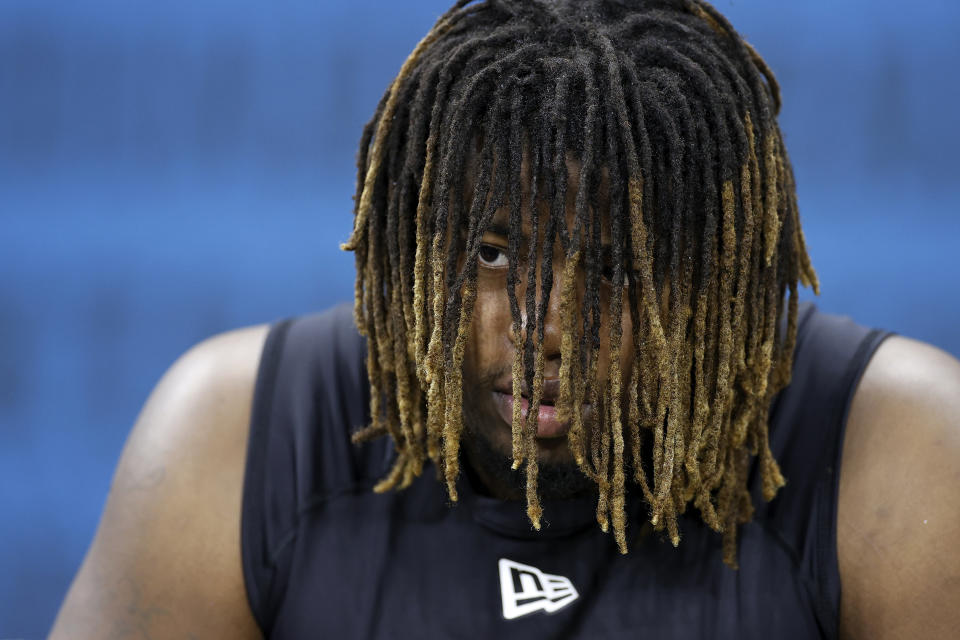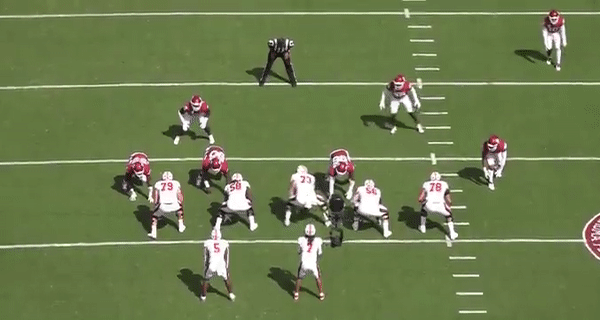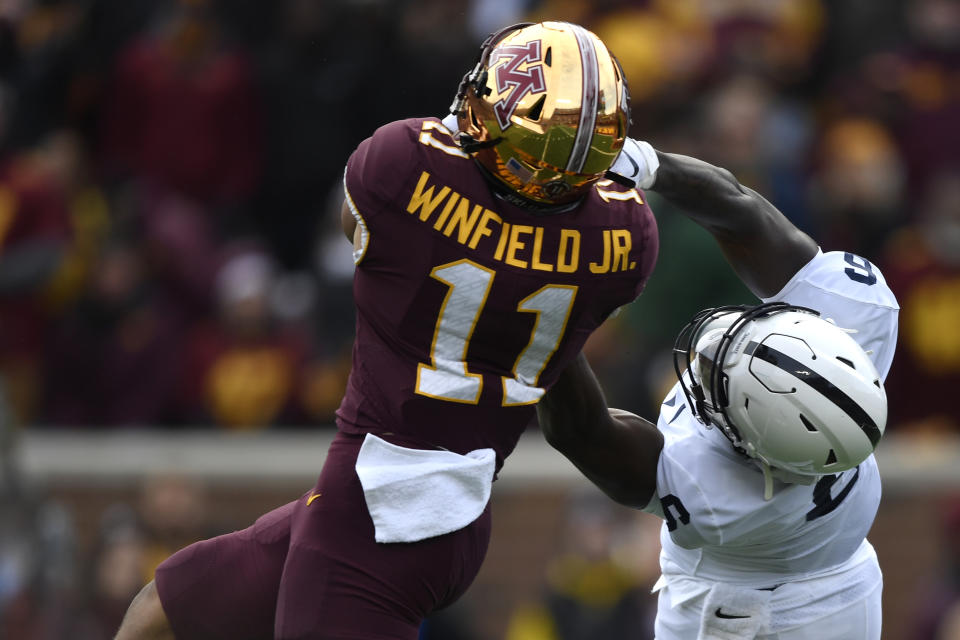2020 NFL draft: Minnesota's Antoine Winfield Jr. (No. 61 prospect) making his own name
Leading up to the 2020 NFL draft, which starts April 23, Yahoo Sports will count down our top 100 overall prospects. We’ll count them down in groups of five and 10 at a time, followed by in-depth reports on our top 50 players. We reserve the right to make changes to players’ grades and evaluations based on injury updates, pro-day workouts or late-arriving information from NFL teams.
Previous prospect rankings: Nos. 100-91 | 90-81 | 80-71 | 70-66 | 65-61 | 60-56 | 55-51 | 50. DT Justin Madubuike | 49. CB Damon Arnette | 48. OT Ezra Cleveland | 47. WR KJ Hamler | 46. CB A.J. Terrell | 45. RB Cam Akers | 44. DL Ross Blacklock | 43. OT Josh Jones | 42. DT Jordan Elliott | 41. C Cesar Ruiz | 40. S Kyle Dugger | 39. EDGE Terrell Lewis | 38. WR Laviska Shenault Jr. | 37. S Grant Delpit | 36. Jonathan Taylor | 35. WR Brandon Aiyuk | 34. EDGE Zack Baun | 33. EDGE Yetur Gross-Matos | 32. CB Jeff Gladney | 31. QB Jordan Love | 30. CB Trevon Diggs | 29. EDGE A.J. Epenesa | 28. RB JK Dobbins | 27. WR Justin Jefferson | 26. WR Tee Higgins | 25. S Xavier McKinney | 24. WR Jalen Reagor | 23. CB Kristian Fulton | 22. RB Clyde Edwards-Helaire | 21. WR Denzel Mims | 20. LB Kenneth Murray | 19. RB D’Andre Swift | 18. QB Justin Herbert | 17. LB Patrick Queen | 16. WR Henry Ruggs III | 15. EDGE K’Lavon Chaisson | 14. WR Jerry Jeudy | 13. OT Mekhi Becton | 12. DT Javon Kinlaw | 11. OT Andrew Thomas | 10. OT Tristan Wirfs | 9. WR CeeDee Lamb | 8. OT Jedrick Wills Jr. | 7. CB CJ Henderson | 6. LB-S Isaiah Simmons | 5. DT Derrick Brown | 4. QB Tua Tagovailoa | 3. CB Jeffrey Okudah | 2. QB Joe Burrow | 1. Chase Young

65. LSU OG Damien Lewis
6-foot-2, 327 pounds
Yahoo Sports draft grade: 5.84
The lowdown: After two years as the starting right guard at Northwest Mississippi Community College, Lewis started in that same spot for the Tigers for all 13 games in 2018 and all 15 games in 2019, helping his offensive line win the prestigious Joe Moore Award (given to the best offensive line in college football) and helped deliver LSU the national title.
Lewis is a well-built, country-strong guard with NFL-caliber traits. Experienced as a pass and run blocker, he improved in each area from his junior to senior seasons, and earned a lot of respect inside the program for his work ethic, leadership and bulldog mentality. Lewis and center Lloyd Cushenberry were considered the two most accountable and respected senior members of that talented group.
If you watched only the Auburn tape, you might wonder what all the hype is with Lewis. He struggled badly for the first two-plus quarters, allowing two sacks (one nearly a safety) and was flagged for a hold that wiped out a first-down run. Lewis lost battles to possible top-10 pick Derrick Brown, but if you look at LSU’s two second-half TD drives, Lewis got the best of Brown on some matchups.

Lewis can get his feet stuck on contact and will operate from too wide a base, and his height puts him on the bottom end of what some teams will consider at guard. He might not be a perfect fit in a zone-blocking scheme that requires guards to pull out and move into space, and Lewis has some issues with quickness.
His power is tangible, as he’s almost never overwhelmed at the point of attack, and he’ll be a perfect fit for a gap-blocking scheme where his pancake ability and nastiness can be accentuated. Lewis reminds us a little bit of New Orleans Saints OG Larry Warford, a run-blocking ace with a mean streak who has been named to three Pro Bowls in his six NFL seasons.
By the numbers: Lewis allowed four sacks, three QB hits and seven QB pressures in 608 pass-blocking snaps in 2019, per PFF. Those numbers in 2018: one, one and six on 481 pass-blocking snaps.
Interesting fact: Lewis took part in a program called “In His Steps Ministries” in his hometown of Canton, Mississippi. It’s a Christian organization that helps at-risk children and juvenile offenders and their families.
Lewis’ father, Damien Dozier, was convicted on drug-related charges in 2011 and remained in prison until 2018. Without a father at home during those year, the pastor from “In His Steps Ministries” and his wife took Lewis to football camps across the Southeast because his mother didn't have a car.
Draft range: There have been some late Round 1 whispers for Lewis, but he’ll land somewhere in the early-to mid-second-round range.
64. Oklahoma DT Neville Gallimore
6-foot-2, 304 pounds
Yahoo Sports draft grade: 5.85
The lowdown: The Ontario-bred Gallimore has taken a fascinating path. After a redshirt season (during which Gallimore said his biggest adjustment was to the Oklahoma heat), he emerged as a starter by the end of 2016 and into 2017 before an injury disrupted his sophomore season. And following a strong, rebound in 2018, Gallimore took an even bigger step up as a redshirt senior — thanks to dropping 30 pounds — to earn third-team AP All-America mention with 7.5 tackles for loss, four sacks and two forced fumbles in 14 games in 2019.
With a shorter, stockier build, Gallimore wins with quickness off the snap and outstanding tenacity. He’s almost impossible for slower-footed centers and guards to reach block and can knife through gaps with surprising ease at times. Gallimore also has a good habit of seeking contact on the ball and became a more sure tackler as a senior.
It’s rare to see Gallimore take a play off, and his effort often pays off. Watch him work back against the grain to chase down an agile quarterback on a read-option keeper — a play that most men his size won’t ever make:

There are times when Gallimore’s bull-in-a-China-shop, hair-on-fire style works against him. He can run himself out of plays and lose gap contain trying to do too much. Gallimore is on the ground more than we’d like to see, and his college production was inconsistent. He also can stand straight up in his stance as a rusher at times and has short arms that will hinder him.
Gallimore, who turned 23 in January, reminds us — style-wise — a lot of Pittsburgh Steelers 2016 third-round pick Javon Hargrave as a prospect, even though Gallimore will enter the league with far more experience in high-level college football. Hargrave developed from a good part-time player in his first few seasons to a higher-snap contributor and the kind of penetrator who will be paid on the open market this offseason.
That’s the type of path Gallimore could take in the early stages of his career, and if the Steelers let Hargrave walk this offseason, Gallimore is the kind of high-energy rusher they could seek to replace him with. It’s likely he’ll see more time at the 3-technique in the NFL but he also could play his college position of nose tackle in passing-down fronts.
By the numbers: In 46 games with the Sooners, Gallimore totaled 147 tackles (17 for losses), 8.5 sacks, two batted passes and five forced fumbles.
Interesting fact: At Canada Prep Academy (formerly Canada Prep Football Academy) — a private, all-boys school in St. Catharines, Ontario that’s the only Canadian school to play a full schedule of American high school football teams — Gallimore established himself as a top-100 recruit.
Gallimore played there for Geoff McArthur, who was Aaron Rodgers’ go-to receiver at Cal in 2003 and 2004. Gallimore worked with McArthur, who was training high-school athletes in Los Angeles, flying there with the hopes of attracting the eyes of American coaches. McArthur landed Gallimore and predicted then that he would be an NFL player while still in high school.
Nicknamed the “Canadian Bulldozer” by a Twitter poster in 2017, Gallimore is expected to be only the third known Ottawa high-school player who will end up in the NFL, following QB Jesse Palmer and DT Christo Bilukidi.
Draft range: Round 2, perhaps early Round 3
63.Baylor DL James Lynch
6-foot-4, 289 pounds
Yahoo Sports draft grade: 5.85
The lowdown: Lynch reneged on a USC commitment in 2017 and became one of (now Carolina Panthers head coach) Matt Rhule’s first key recruits. Following a solid freshman year and an improved sophomore performance, Lynch became one of the Bears’ best all-around players in 2019, earning first-team AP All-American and Big 12 Defensive Player of the Year with 19.5 tackles for loss, 13.5 sacks, five passes defended, three forced fumbles and two blocked kicks in his 14 starts.
Lynch declared early for the 2020 draft and turned 21 in January. He enters the NFL as a fascinating prospect but also one who comes with questions. Can the nearly 300-pound Lynch play on the edge — he was an end in Baylor’s 3-3-5 base defense — as he did for the Bears? Not likely, and Lynch’s limited length (with surprisingly short arms at 31 7/8 inches) might make him less than ideal to be a 5-technique in a 3-4 front.
Does Lynch have the quickness to win inside consistently? It’s a more likely scenario for his NFL projection, and teams we’ve spoken to believe he has the strength, surprising quickness, high motor and active hands to be successful in a role inside, even if his sack and TFL production might not be as prolific.
Adding some subtlety to his pass-rush plan will benefit Lynch, who too often tried to overpower blockers with power and effort. He also can get jumpy trying to time up the snap (see Georgia game) to compensate for his lack of elite traits, and will need to clean up his slew of missed tackles — 15, according to PFF, which was tied for the most among college defensive linemen last season.
Lynch’s rare motor and ascending production are harbingers for NFL success, even if he might take time to earn a starting role. The league is always on the lookout for rotational linemen who also can block kicks. Lynch can become a disruptive force in the mold of the Denver Broncos’ Derek Wolfe.
By the numbers: Lynch was an absolute horse for Rhule and defensive coordinator Phil Snow last season, rarely leaving the field. He played 862 snaps this past season, tied for the most of any defensive lineman in FBS with East Carolina’s Alex Turner. Lynch’s engine revved hot, even as Baylor played in eight one-score games and had a double-OT and a triple-OT game. Lynch played 80 or more snaps in four games this season (including 89 of 97 snaps in the first Oklahoma game), which is an unheard of total for a nearly 300-pound player.
Interesting fact: In Lynch’s freshman year of 2017, Baylor punter Drew Galitz was lost for the season with a knee injury. That left kicker Connor Martin as the replacement punter, but Rhule needed an emergency option.
Oh, yes. And for decent reason, too. Lynch punted at Round Rock (Texas) High School his senior season, averaging more than 43 yards per punt.
Sadly, he was never asked to punt in a game, even with the Bears going 1-11 that season.
Draft range: Top-60 pick
62. LSU C Lloyd Cushenberry
6-foot-3, 312 pounds
Yahoo Sports draft grade: 5.85
The lowdown: Cushenberry, who turns 23 in November, was a two-year starting center for the Tigers. He declared early for the 2020 draft after earning second team All-America honors in 2019, leading his unit to the Joe Moore Award (given to college football’s top offensive line).
Cushenberry’s intangibles are considered elite. He’s tough, smart and accountable as one of LSU’s unquestioned team leaders, holding others accountable and asked by the staff to mentor younger, less mature players. His work in the weight room paid off, as Cushenberry maxed out his good (but hardly special) athleticism to turn in solid scouting combine numbers in the bench and 40-yard dash, despite pulling his hamstring on his second attempt.
Cushenberry lacks great movement for his size, allowed pass rushers to cross his face far too regularly and might be a one-position player in the NFL. He struggled early in the season while adjusting to the Tigers’ new up-tempo system, which required him to make the line calls, set protections and ID defensive fronts. As a result, he committed two penalties (including an uncharacteristic personal foul against Northwestern State) and was credited with allowing three sacks and nine pressures in the first three games.
Once he and the Tigers got going, they operated one of the best offenses in college football history — and part of that success was because so much responsibility was left on QB Joe Burrow and the five blockers up front. LSU didn’t used much max protection, often leaving five or six blockers home, even against pressures.
Even with his limitations, Cushenberry projects as a smart, capable, tough and fairly strong pivot. His strength to handle bull rushers and ability to persevere and motivate others cannot go overlooked.
By the numbers: Cushenberry started 28 consecutive games at center (the Tigers were 25-3 during that span), including every game of Burrow’s LSU career
Interesting fact: LSU has been awarding the No. 18 jersey for the past 16 years to players who, according to the school, best represent what it means to be an LSU football player — on and off the field. Cushenberry became the first LSU offensive lineman to earn the honor in 2019, sharing it with K'Lavon Chaisson. Although NCAA rules required Cushenberry to keep his No. 79 jersey, he wore an “18” patch on his jersey.
Draft range: Top-60 pick
61. Minnesota S Antoine Winfield Jr
5-foot-9, 203 pounds
Yahoo Sports draft grade: 5.85
The lowdown: One of the more fascinating developments in the Big Ten was the breakout season for the Gophers and also for their big-play safety, Winfield. Entering last season, he was best known as the injury-prone son of the Minnesota Vikings cornerback, but the younger Winfield made a name for himself with a seven-interception, 88-tackle, three-sack season that earned him first-team all-Big Ten and AP All-America mention.
And best yet: He played all 13 games. Winfield earned a starting role as a freshman, notching an 82-yard pick-six in his fourth college game. His sophomore and junior seasons both ended in major injuries — a hamstring in 2017 and a foot in 2018. (Strangely, both occurred in games against Maryland.)
That has raised questions about whether his durability will be an issue in the NFL. Other factors that compound that worry are that Winfield doesn’t possess ideal size and that he — like his father — are hard-nosed, aggressive tacklers in space. That last part is a strength for Winfield as a player, but it’s something that’s mentioned alongside his injury worries.

Still, Winfield inherited great genes from his father, an extremely smart player who lasted 15 years in the NFL, played nearly 200 games in the league.
Where the younger Winfield excels is with his timing and route recognition. He looks like Torii Hunter shagging flies with ease in center field, tracking down balls and short-circuiting a lot of good passing games this past season. Winfield also times his arrival at the ball extremely well (one career penalty, which happened his freshman year) and times his blitzes well, too. His 40 time at the NFL combine (4.45) was much higher than the mid-4.5s some scouts were expecting.
Although he spent plenty of time in the box for the Gophers, Winfield projects to more of a middle-field safety in the NFL. Those NFL-ready instincts will serve him well in an early starting role, even if he might come just short of All-Pro potential. His size, injury history and lack of ideal range were enough to keep him just out of our top 50 prospects.
By the numbers: In 1,051 defensive snaps prior to 2019 at Minnesota, Winfield logged two interceptions. Last season, he had seven — including the game-clinching picks against Fresno State and Penn State.
Interesting fact: Winfield, who turns 22 in August, was actually a fourth-year sophomore when he declared early for the draft, which is extremely rare. He was granted two medical redshirts following his 2017 and 2018 campaigns.
Draft range: Top-60 pick
More from Yahoo Sports:
